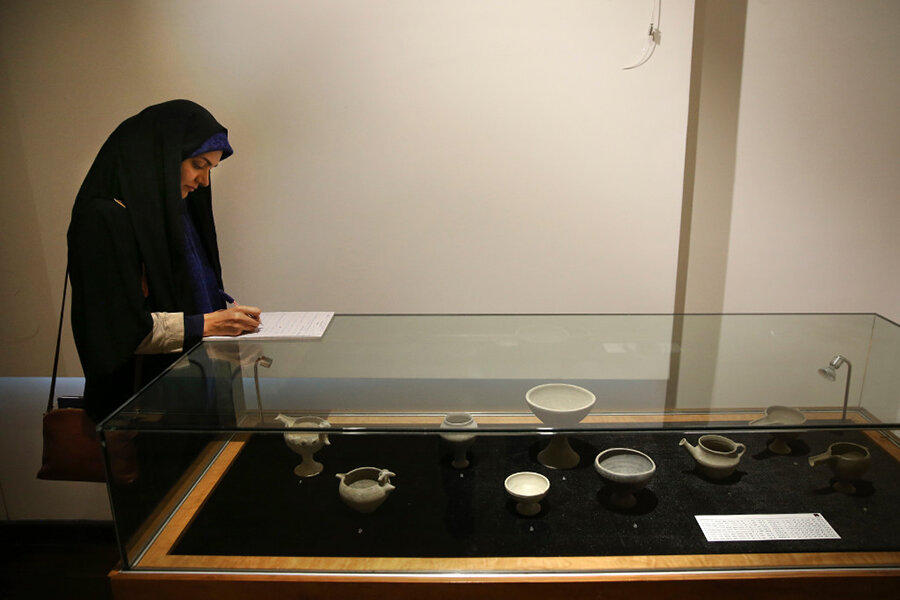One year after nuclear deal, Iranian museum welcomes collection home from abroad
Loading...
On Monday, a museum in Tehran opened an unusual exhibit of ancient artifacts from ancient Persian history.
The artifacts are part of present-day Iranian's Persian heritage, but until about two and a half years ago, they were all held by Western nations.
Iran has had tenuous relations with the West for decades and no official diplomatic relations with the US at all since 1979, when Iranian students and held American hostages trapped in the US embassy for 444 days. But the 2015 nuclear deal between Iran and the West has helped thaw relations in the art world, Mohammad Hassan Talebian, the deputy head of the Cultural Heritage, Handicrafts and Tourism Organization of Iran, told the Associated Press.
"The atmosphere after the nuclear deal was very important," Mr. Talebian said. "It made it easy to bring back all these objects home."
Some of the items that came from the University of Chicago had previously been displayed in Iran, but this is the first time the collection from all four countries – England, Belgium, Italy, and the United States – has been exhibited together.
Some highlights of the exhibit include hunting tools and needles dating back to the Iron Age, as well as two 2,000-year-old necklaces from the Achaemenid Empire, one of the largest in history. The display also includes ancient coins and bowls that are around 3,500 years old. Many of these ancient objects, withheld for so long by Western museums, hold great meaning and value for modern Iranians, as a link to the illustrious and ancient past of the Persian Empire.
The special exhibit in the National Museum of Iran includes 558 different artifacts and is entitled "The Exhibition of the Repatriated Cultural-Historical Objects."
But despite a thaw in US-Iranian relations over the past year, a more recent escalation in tensions following the election of President Trump in the United States may mean that any international cooperation between the two countries could be short-lived.
"It is not yet clear whether the fate of the nuclear deal will be immediately subject to the presidential pen," as The Christian Science Monitor reported last month:
The answer to a central question may inform action: Are we safer with the Iran nuclear deal than without it?
Many analysts – and apparently even Israeli security officials – say yes, noting that since former President Obama's choice to favor diplomacy over war, critical elements of Iran’s program have been curtailed, such that the potential “breakout time” to a weapon has moved from several weeks to more than a year. Lowering tension on the nuclear file, however, has not diminished continued concerns in Washington about Iran’s missile program and involvement in Syria and Iraq, with its own forces and proxy Shiite militias.
Still, analysts recall dark days before the deal in which Iran’s surging capabilities all appeared to risk another Middle East war. Those included moving in one decade from 300 to some 19,000 spinning centrifuges to enrich uranium, for example, and the assassination of Iranian nuclear scientists as well as US-Israeli cyber attacks.
The new exhibit comes as tensions ramp up over a recent Iranian missile launch, which drew condemnation from the Trump administration. Meanwhile, Mr. Trump's temporary travel ban against seven predominately-Muslim countries, including Iran, was promptly followed by Iran saying it would implement its own ban against US visitors.
"We are thankful to this gentleman [Trump] who’s come along! He's made our job a lot easier – he’s shown the true face of America," Ayatollah Ali Khamenei, Iran's Supreme Leader, told Iranian Air Force officers on Tuesday. "No enemy can paralyze the Iranian nation."
The harsh rhetoric on both sides has cast doubt on the future of the nuclear deal and Iran's relationship with the West. But for now, the exhibition in Tehran stands a monument to both the ancient history of Iran and to the unexpected benefits of peace and understanding.
"This is source of great pride and pleasure, because our identity, which is subject to disintegration, is becoming whole again," said Myriam Rahgoshay, an arts enthusiast, told the Associated Press.
This report contains material from the Associated Press.






